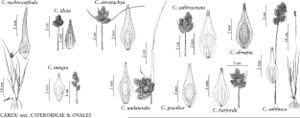Carex subbracteata
Bull. Torrey Bot. Club 43: 612. 1917.
Plants densely cespitose. Culms often lax, supported by other vegetation, 27–105 cm. Leaves: sheaths white-hyaline or green-veined with central white-hyaline strip, summits U-shaped to rounded, sometimes prolonged beyond collar; distal ligules 1.5–5.5 mm; blades 3–6 per fertile culm, 12–65 cm × 1.3–3.7(–4.6) mm. Inflorescences dense to open, green and brown, gold and brown, or brown, 1.3–3.5 cm × 7–23 mm; proximal internode 2–3(–4.5) mm; 2d internode 1–3 mm; proximal bracts bristlelike or rarely leaflike, longer than inflorescences. Spikes 4–11, densely aggregated, at least proximal 1–3 distinct, ovoid to broadly ovoid, 6–12.3 × 3.8–9.1 mm; base rounded; apex acute to rounded. Pistillate scales brown, red-brown, or coppery, with whitish, green, or pale brown midstripe, ovate, (3.2–)3.5–4.5 mm, shorter, narrower than, or covering perigynia, margin often indistinct, white, 0–0.4 mm wide, apex ± obtuse or rarely short-awned. Perigynia ascending to spreading, straw colored or gold to coppery, conspicuously (0–)5–9-veined abaxially, conspicuously 0–6-veined adaxially, veins not reaching top of achene, ovate to broadly ovate, plano-convex to biconvex, (2.9–)3.5–4.7(–5.7) × 1.2–1.7(–2.2) mm, 0.5–0.75 mm thick, ± leathery, margin flat, including wing 0.2–0.4 mm wide, ciliate-serrulate at least on distal body, with metallic sheen; beak often brown to dark brown at tip or white-hyaline, cylindric, unwinged, abaxial suture inconspicuous, distance from beak tip to achene 1.5–2.2(–2.6) mm, ± entire for (0.3–) 0.4–0.8 mm. Achenes broadly ovate to quadrate, 1.3–2.1 × 1–1.5(–1.7) mm, 0.5–0.6 mm thick.
Phenology: Fruiting spring–summer.
Habitat: Meadows, swales, moist places, roadsides, along the coast and in Coast Ranges
Elevation: 0–900 m
Discussion
Carex subbracteatais very similar to and perhaps conspecific with C. gracilior (R. Whitkus 1988).
Selected References
None.

